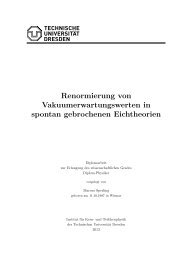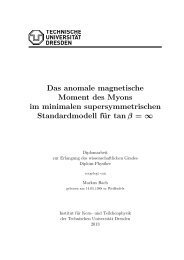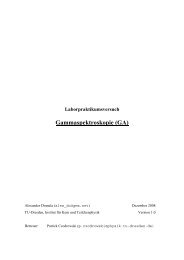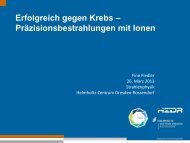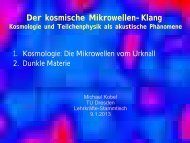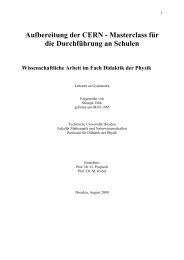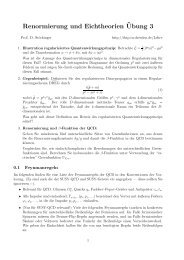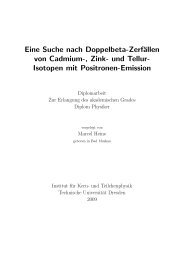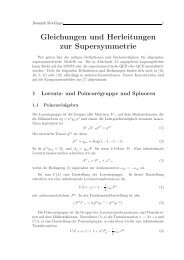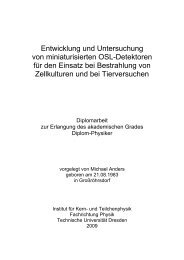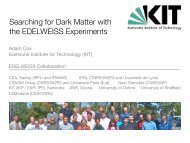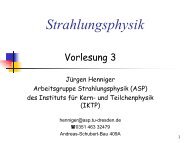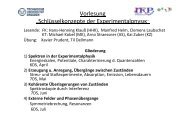a design study for a cobra upgrade to - Institut für Kern- und ...
a design study for a cobra upgrade to - Institut für Kern- und ...
a design study for a cobra upgrade to - Institut für Kern- und ...
You also want an ePaper? Increase the reach of your titles
YUMPU automatically turns print PDFs into web optimized ePapers that Google loves.
62 5 Scintilla<strong>to</strong>r <strong>upgrade</strong><br />
vice. The length of the light guide depends on the number of devices<br />
and the readout size. A visualisation, using the visualisation system<br />
Heprep, is shown in fig. 5.3.<br />
With this developed Geant4 application, different aspects of the scintillation<br />
detec<strong>to</strong>r preparation were studied.<br />
DATA ANALYSIS<br />
Be<strong>for</strong>e starting the comparison between the readout devices, the influence<br />
of the housing finish, reflectivity and absorption length was studied.<br />
There<strong>for</strong>e all 6 different kinds of housing finish were simulated<br />
with a PMT readout, covering the front faces of the crystal. The finish<br />
”polished” yields highest amount of pho<strong>to</strong> electrons. Gro<strong>und</strong>, gro<strong>und</strong>and<br />
polished-frontpainted yield aro<strong>und</strong> 75 % of the previous amount<br />
of pho<strong>to</strong> electrons. The gro<strong>und</strong>- and polished-backpainted finish only<br />
aro<strong>und</strong> 60 % of the pho<strong>to</strong> electron yield, obtained with a polished surface.<br />
The influence of the surface finish on the uni<strong>for</strong>mity of the signal <strong>for</strong><br />
different source positions was not studied, but a higher uni<strong>for</strong>mity of<br />
light collection <strong>for</strong> gro<strong>und</strong>, than <strong>for</strong> polished surfaces is expected [29].<br />
The further simulations were carried out with a gro<strong>und</strong> surface finish<br />
and a reflectivity of 0.98.<br />
As main examination, the amount of pho<strong>to</strong> electrons detected by different<br />
readout devices was evaluated. There<strong>for</strong>e these 7 readout devices<br />
were simulated with different sizes of active area. In a first simulation,<br />
the readout devices covered the entire front facing crystal side, in<br />
another simulation, only commercially available sizes <strong>for</strong> the readout<br />
devices were taken in<strong>to</strong> account. 10000 events with 662 keV pho<strong>to</strong>ns<br />
were simulated and the amount of produced pho<strong>to</strong> electrons was only<br />
recorded if the incident pho<strong>to</strong>n was completely absorbed. This was<br />
the case <strong>for</strong> about 5900 events. The mean values of the recorded pho<strong>to</strong><br />
electron number and the relative standard deviation <strong>for</strong> the different<br />
readout areas and quantum efficiencies are listed in table 5.5.<br />
RESULTS<br />
The crucial point of this simulation is the limited knowledge about the<br />
actual optical properties of individual crystals. This simulation can<br />
there<strong>for</strong>e give only an estimation of the expected numbers of detected<br />
pho<strong>to</strong> electrons. Properties, like the optical absorption length, depend<br />
on the crystal quality and production process. The increase of the optical<br />
absorption length from 10 cm <strong>to</strong> 100 cm, improves the simulated<br />
amount of detected pho<strong>to</strong>ns significantly by almost a fac<strong>to</strong>r of 10. This<br />
simulation is nevertheless useful <strong>for</strong> comparing the spectral matching<br />
and the influence of the size of different readout devices.



